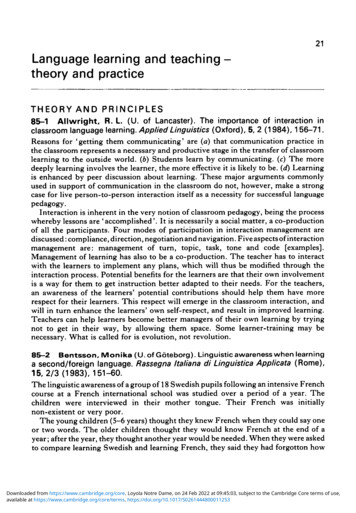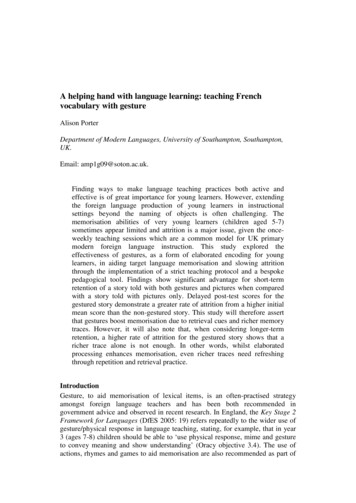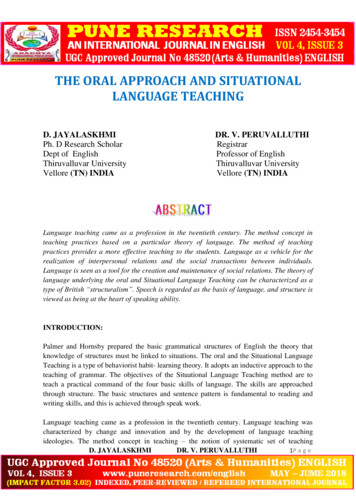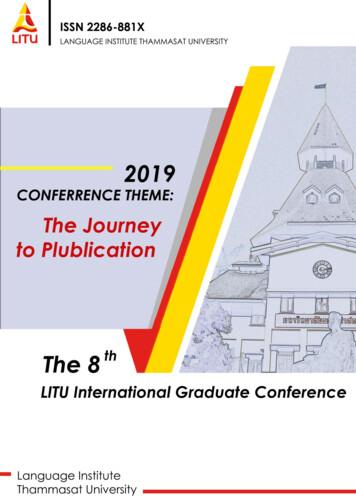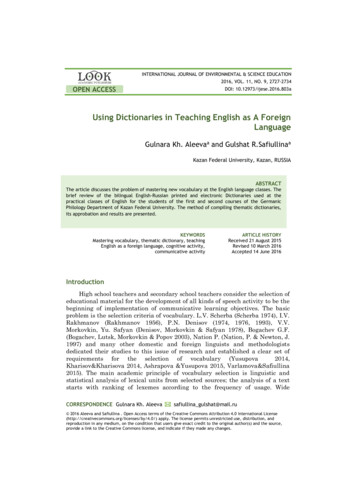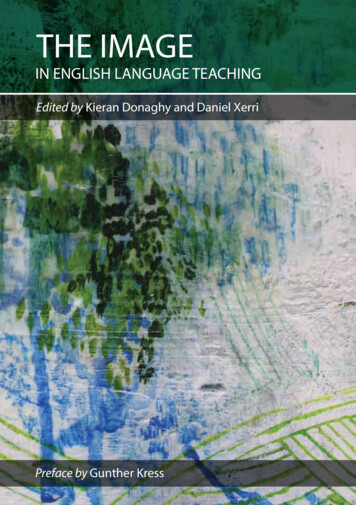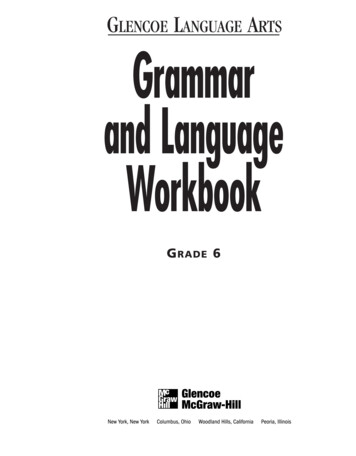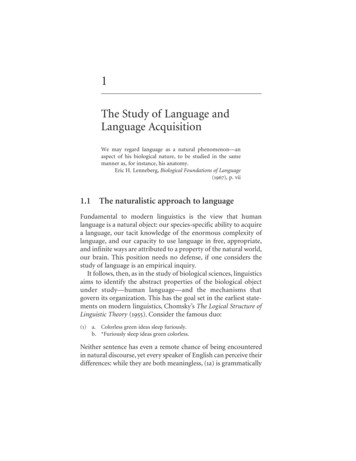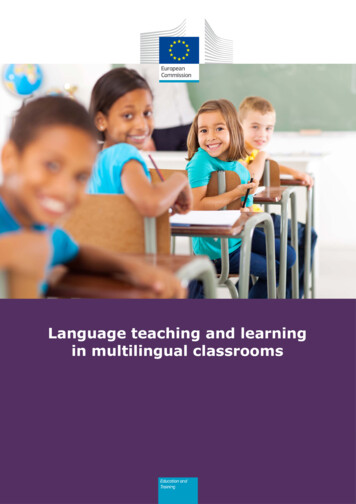
Transcription
Language teaching and learningin multilingual classrooms
Language teaching and learning inmultilingual classroomsEUROPEAN COMMISSIONDirectorate-General for Education and CultureDirectorate B — Education policy and programme; Innovation, EIT and MSCAUnit B.2 — Schools and educators; multilingualismE-mail: EAC-UNITE-B2@ec.europa.euEuropean CommissionB-1049 ing-languages/multilingual-classrooms en.htm
EUROPEAN COMMISSIONLanguage teaching andlearning in multilingualclassroomsPrepared by ICF Consulting Services LtdDirectorate-General for Education and Culture2015EN
DisclaimerThis document has been prepared for the European Commission; however, itreflects the views only of the authors, and the Commission cannot be heldresponsible for any use which may be made of the information contained therein.Europe Direct is a service to help you find answersto your questions about the European Union.Freephone number (*):00 800 6 7 8 9 10 11(*)The information given is free, as are most calls (though some operators, phoneboxes or hotels may charge you).More information on the European Union is available on the Internet (http://europa.eu).Luxembourg: Publications Office of the European Union, 2015ISBN 978-92-79-51830-0doi: 10.2766/766802 European Union, 2015Reproduction is authorised provided the source is acknowledged.Photo (cover): shutterstick.com
Education and TrainingTable of ContentsTable of Contents . 5Terms and definitions. 8Executive summary . 9Focus of this study . 9The challenge . 9Method. 9Reception and integration . 10Access to the curriculum . 11Developing mother tongue competences . 11Teacher education. 12Conclusions: What will make a difference?. 12Recommendations: What will facilitate making a difference? . 14Introduction . 16Purpose of this research . 16Context . 16EU policy . 16Commission guidance and support within the Open Method of Coordination (OMC). 17The educational achievements of migrant children . 18The growth and extent of multilingual classrooms. 22National policies and responses. 25Method . 26Broad assumptions. 26Considerations. 27Approach . 28A framework for the review of evidence and this report . 29Reception and integration . 30Access to the curriculum . 30Developing mother tongue competences . 30Teacher education. 30Theme 1: Reception and integration. 31Participation in early childhood education and care . 31Research evidence . 31Practitioners’ views and experience . 32Lessons for policy and practice. 33Placement and admission. 34Research evidence . 34Practitioners’ views and experience . 34Lessons for policy and practice. 36Assessment of language support needs. 36Research evidence . 36Practitioners’ view and experience . 37Lessons for policy and practice. 38Learning the language of instruction for integration into the school system . 39Research evidence . 39Practitioners’ views and experience . 40Lessons for policy and practice. 42Key summary points . 42Participation in ECEC . 42Placement and admission . 425
Education and TrainingAssessment of language support needs . 43Learning the language of instruction for integration into the school system . 43Theme 2: Access to the curriculum . 44Support in the classroom for language and subject learning . 44Research evidence . 44Practitioners’ views and experience . 45Lessons for policy and practice. 46Support outside the classroom. 47Research evidence . 47Practitioners’ views and experience . 48Lessons for policy and practice. 51Adapted teaching approaches by class teachers . 51Research evidence . 52Practitioners’ views and experience . 53Lessons for policy and practice. 54Parental engagement . 55Research evidence . 55Practitioners’ views and experience . 56Lessons for policy and practice. 58Key summary points . 58Support in the classroom . 58Support outside the classroom . 58Theme 3: Developing mother tongue competences . 60Recognising and developing mother tongue competences in informal and non-formallearning . 60Practitioners’ views and experiences . 60Lessons for policy and practice. 63Developing mother tongue competences in formal learning. 63Research evidence . 63Practitioners’ views and experience . 65Lessons for policy and practice. 71Key summary points . 71Non-formal and informal learning of mother tongues. 71Formal learning of mother tongues . 71Theme 4: Teacher education . 73Developing language development skills and cultural competences . 73Practitioners’ views and experiences . 73Lessons for policy and practice. 74Developing skills for teaching children without the language of instruction . 75Research evidence . 75Practitioners’ views and experience . 76Lessons for policy and practice. 78Key summary points . 79Teacher education in language teaching skills and cultural competences . 79Teacher education to develop skills to support children without the language ofinstruction in the classroom. 79Conclusions . 80Research evidence gaps . 80What makes a difference . 80What are the factors working against migrant children achieving their potential? 80What brings about higher attainment and reduced gaps in achievement andprogression? . 81What increases children’s development of their multi-lingual skills . 81What improves inter-cultural education? . 816
Education and TrainingWhat facilitates making a difference . 82ANNEXES . 85Annex 1 Research protocol. 85Annex 2 Bibliography . 897
Education and TrainingTerms and definitionsInvariably there are many different terms used in the literature to describe childrenwho have learnt a different language before they enter education in a country whetherthat is at the start of compulsory education because they have a learnt a differentlanguage at home or during compulsory education because they are recently arrivedmigrants from a country where another language was spoken. In all cases they areexpected to learn the language which is used for instruction and assessment so thatthey access the curriculum and progress to higher education and employment.In this report, these children will all be described as ‘without the language ofinstruction’ even where they are described differently in the literature being drawn onwhere many different terms are used depending on the country context. Where theyare distinguished generically as being the children of parents who have migrated inthe literature (not all of whom will have learnt a different language at home), theymay be described as migrant children.The language they have learnt at home from their parents and/or in school in anothercountry is also often described in many different ways. Here it will be described as a‘mother tongue’.8
Education and TrainingExecutive summaryFocus of this studyFor the children of migrants, learning the language of instruction and assessment sothat they can enter school or carry on their education is paramount. Educationauthorities in many parts of the EU are faced with this challenge because of growinglevels of mobility. Enabling such children to access teaching and learning quickly iscritical to ensuring they can reach their potential and progress to higher education andemployment to the same degree as non-migrant children. In the process the childrenthemselves gain linguistic and meta-linguistic skills from learning the language ofinstruction and assessment in addition to their mother tongue.This research is designed to gather, analyse and synthesise existing data and researchon: What works to enable migrant children who use a language at home differentto the language of school instruction to participate in learning, attainproficiency in the language of instruction, and achieve results (qualifications,progress to higher education, progress to employment) that match theirpotential; and What works to maintain and develop the multilingual skills of migrant childrenwhich will enable them to use these competences for cultural and economicpurposes.The challengeBecause of increasing mobility multilingual classrooms are becoming morecommonplace in many EU countries as is the range of mother tongues that childrenhave.It is clear that: Migrant children without the language of instruction do not reach their potentialand are more likely to leave school early and have lower levels of attainmentthroughout their schooling;Children are not always provided with support to learn their mother tongue;Schools can reduce the difference in attainment between native children andchildren without the language of instruction as they progress through theireducation.It is accepted in this study that learning the language of instruction is necessary forchildren to reach their potential, that bilingualism increases children’s cognitive skillsand their ability to learn languages effectively and that barriers affect the educationaloutcomes that children without the language of instruction can achieve.MethodTo address these questions, the study has comprised: A literature review drawing on academic research and grey literature;A series of round table discussions involving practitioners and experts; andA study visit to Cologne to see what is happening on the ground and to havefurther discussion with practitioners and experts.It was important for the study to include research which was based on empiricalevidence and practitioners’ experiences provided that:9
Education and Training The methods and their limitations were understood so that the strength ofevidence could be assessed;The context was known so its transferability could be considered; andPractitioners’ experience was drawn on in a systematic way (such as throughworkshops and action research).The study examined evidence in relation to four themes. The key findings on each ofthese is set out below.Reception and integrationParticipation in early childhood education and care (ECEC)There is conclusive research evidence which shows that ECEC can have positivelearning and progression outcomes for migrant children which gives them the startthey need to develop their skills in the language of instruction. Practitioners believethat better results are achieved where there is outreach to ensure migrant childrentake up free provision of ECEC and where ECEC providers have a systematiccurriculum for language learning.Placement and admissionWhile migrant children are segregated and schools with higher proportions of migrantchildren have lower attainment, there is no conclusive research evidence thatsegregation is a cause and that reducing it will improve attainment. Practitionersbelieve that reducing segregation does however help schools to manage and that thegreatest benefit of this comes from increasing cultural awareness of all children. Theyalso believe that it is more important for education authorities to ensure that thequality of leadership and teaching in schools with children without the language ofinstruction can meet the challenges of multilingual classrooms and that such schoolsneed to have additional resources and funding.Assessment of language support needsThere is conclusive research evidence that poor measures of assessment on enteringthe school system have a detrimental impact on migrant children. This is because theyare more likely to be allocated to special education and lower ability tracks.Practitioners have developed better systems for assessing children’s language skillsand other knowledge and competencies during the early stages of their reception intothe education system. These address the causes of poor assessment that haveadversely affected children without the language of instruction.Learning the language of instruction for integration into the school systemThere is indicative research evidence that children without the language of instructionshould be quickly moved to having targeted and continued language support providedin mainstream classrooms (immersion) rather than in separate classes. The amount oftime needed in preparatory education should be linked to age and previous education.Practitioners strongly support a speedy transition with teaching support because theybelieve this supports integration, learning the language of instruction and learningother subjects. Where separate classes are required children without the language ofinstruction should be enabled to make a transition to mainstream classes with aspecial curriculum and support from specialist teachers.10
Education and TrainingAccess to the curriculumSupport in the classroomThere is indicative research evidence that the availability and level of supportimproves migrant children’s educational attainment and that additional learningactivities and support in school for children without the language of instruction canimprove their progress. Practitioners strongly believe that classroom support has to bemaintained to develop their language skills as well as access to the curriculum withthe support of teaching assistants, specialist teachers and resources.Support outside the classroomThere is indicative research evidence that formal and informal learning led by trainedstaff and volunteers outside school enhances migrant children’s interest in education,their language skills and their aspirations. This is through a variety of measures:homework clubs, out of school activities, mentoring, coaching and advice. Practitionersbelieve that these help and can be targeted at children who need extra support whichinclude migrant children. It helps to achieve positive outcomes if some of thestaff/volunteers have the same mother tongue/migrant background as the childrenand parents.Adapted teaching approaches by class teachersThere is indicative research evidence that adapting teaching approaches toaccommodate children without the same level of language ability as native childrenhas a beneficial effect. The adaptions they effectively employ are similar to those usedin Content and Language Integrated Learning (CLIL) settings. There is some evidencethat providing children without the same level of language competency as nativechildren with tools and materials assists them to achieve their potential in assessmenttests. Simplification of the language used in tests has been found to be beneficial.Practitioners believe that teaching approaches need to be adapted in multilingualclassrooms, teachers need to be aware of this, and have strategies and resources tomanage. Practitioners also believe that teachers need to have positive attitudestowards migrant children if they are to achieve their potential and overcome languagebarriers. There is evidence that not all teachers have these positive attitudes.Parental engagementThere is some indicative research evidence that equipping migrant families with skillsto develop their children’s language skills in ECEC helps to accelerate their learning.Practitioners believe that engaging migrant parents is necessary throughout theirchildren’s education to build their emotional support for their children and theircooperation with the school. These are believed to improve their children’s attendance,behaviours and attitudes to learning as well as mutual trust and understandingbetween teachers and parents.Developing mother tongue competencesNon-formal and informal learning of mother tonguesPractitioners believe that informal learning of mother tongues should be provided andencouraged both in the absence of formal learning opportunities and where formallearning of mother tongues is available. The opportunities for children to use anddevelop their mother tongue skills enable them to gain recognition for these skills andsee they are of equal value to other language skills. Children need to be stimulated todevelop and use their mother tongue skills. Parents, schools and the community havebeen shown to play an effective part in this. Resources are available for non-formaland informal learning.11
Education and TrainingFormal learning of mother tonguesThere is conclusive research evidence that learning mother tongues alongside thelanguage of instruction enhances not only their mother tongue competences but alsotheir competences in the language of instruction.There is indicative research evidence that this has: Longer term benefits for educational attainment and reducing the gap betweenmigrant children and native born children;Wider benefits in enhancing children’s confidence and their cultural awarenessand pride in their culture;Longer term benefits in increasing employment opportunities.Practitioners generally support the benefits of mother tongue learning althoughteachers are not always aware of these. Some schools and teachers continue todiscourage speaking in mother tongues. Bringing mother tongues into languagelearning and the language curriculum as well as offering formal learning of mothertongues as foreign languages through language classes and CLIL throughout primaryand secondary education appear to be efficient and effective approaches to achievingthe benefits described in the research evidence. This is facilitated where pluri-lingualapproaches to language learning are adopted, qualified mother tongue teachers areavailable and mother tongues are recognised in the curriculum and schoolexaminations.Teacher educationTeacher education in language teaching skills and cultural competencesPractitioners believe that teachers who provide language support should havespecialist training and qualifications in second‐language acquisition that is aligned withthe approaches implemented in practice. Alongside this practitioners believe that allteachers require training to teach children without the language of instruction and tobe able to value diversity by incorporating cultural diversity within their teaching. Thisshould include intercultural training.Teacher education to develop skills to support children without the language ofinstruction in the classroomThere is some indicative research evidence that in-service training helps teachers tobuild their capability and resources to teach children without the language ofinstruction which improves the attainment of children without the language ofinstruction. Practitioners strongly support this and also believe that initial teachertraining ought to be adapted given the significant and growing proportion of teacherswho will work in multilingual classrooms.Schools and teachers benefit from the resources, networking and training provided byspecialist centres in many countries and cities in the EU. Practitioners have found thatnetworking between and within schools facilitates non-formal learning by teachers tosupport migrant children’s learning.12
Education and TrainingConclusions: What will make a difference?While the research evidence is not comprehensive in covering all the aspects of theeducational system which can improve migrant children’s educational achievements, itgoes a long way to supporting measures targeted at children without the language ofinstruction to enable them to reach their potential.There is a considerable consensus among practitioners about the causes of suchchildren not reaching their potential and broad agreement to the types of solutionwhich have been tested and in some cases embedded in policy and practice.What are the factors working against migrant children achieving theirpotential?The evidence here broadly confirms earlier research published by the Commission thatthe factors which inhibit children without the language of instruction achieving theirpotential are: Schools without sufficient resources and staff with competencies to support thelearning of children without the language of instruction; Assessment tools and assessors with negative perceptions of migrant children’sabilities which allocate more of them to lower ability tracks and specialeducation classes; A lack of opportunities to develop their mother tongue competences to higherlevels. Although the segregation of migrant children occurs widely in the EU, this isnot by itself a factor.What brings about higher attainment and reduced gaps in achievement andprogression?There is conclusive evidence here that ECEC for children without the language ofinstruction not only increases language competences but also long term educationalachievements; that language competences are related to achievement in othercompetences; and that targeted and continued support in language learning enablesthis.There is indicative evidence supported by practitioners that the following contribute toraising the attainment of children without the language of instruction: Supplementary education (both formal and non-formal) in school and out ofschool which includes help with homework, language learning (includingmother tongue learning), and mentoring during activities;Immersion in mainstream classrooms with support from specialists and withteachers who have the competences and experience to tailor teaching tochildren in the class without the same level of competency in the language ofinstruction;Increasing their parents’ support and encouragement in their education,including their development of language competences;Developing their mother tongue competences.There is no conclusive evidence about the length of time that children without thelanguage of instruction should spend in preparation classes but there is indicativeevidence that this should be limited and should include a transition to immersion withsupport. It should be greater for older children (NAMS) so that they make thetransition once thy have a basic competency.What increases children’s development of their multi-lingual skills?13
Education and TrainingThere is indicative evidence that children without the language of instruction canincrease these skills to higher levels where: ECEC enables them to learn their mother tongue as well as the language ofinstruction;Non-formal and informal learning opportunities enable them to use theirmother tongue;Formal learning opportunities are available either in school or out of school todevelop their mother tongue skills which progress towards recognition ineducational achievements.What improves inter-cultural education?Practitioners strongly believe that intercultural education is more likely to be achievedand achieved more quickly where schools are less segregated and children are morerapidly immersed in mainstream classrooms. This is because this provides greateropportunities for cultural awareness and valuing diversity through teaching andlearning.There is indicative evidence that the following is beneficial: Increasing all children’s cultural and linguistic awareness through bothlanguage learning and other parts of the curriculum;Engaging parents in the school’s activities and their children’s education;Increasing teachers’ positive attitudes towards migrant children’s prospects andtheir use of their mother tongues to learn.Recommendations: What will facilitate making a difference?For policy makers in national and local government, these are:
Learning the language of instruction for integration into the school system There is indicative research evidence that children without the language of instruction should be quickly moved to having targeted and continued language support provided in mainstream cl
